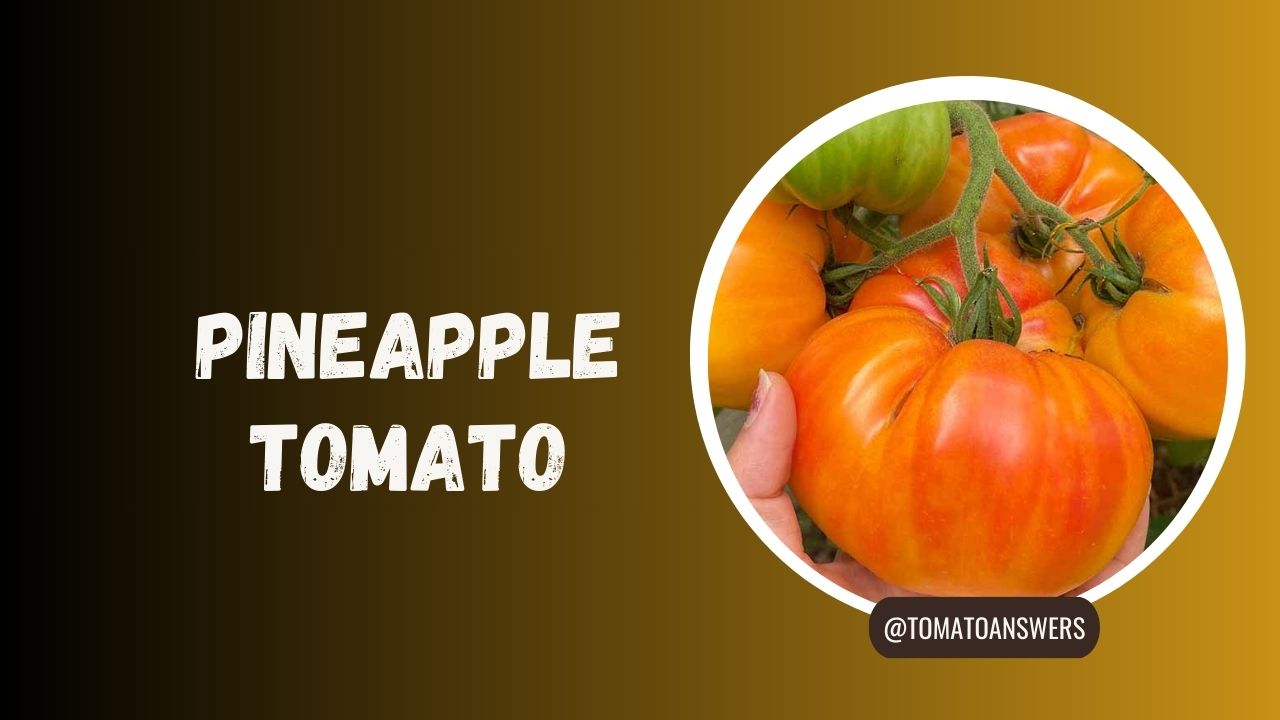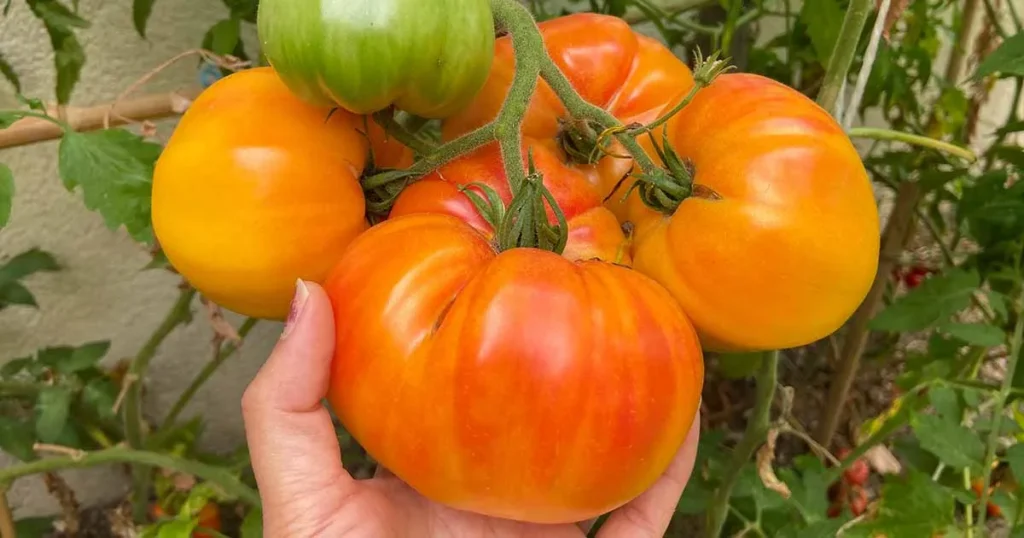Pineapple Tomato: What You Need To Know?
Pineapple tomatoes are a fun and tasty hybrid fruit gaining popularity with home gardeners and consumers looking for unique produce.
This cross between a pineapple and tomato offers the best of both worlds – the sweet tropical flavor of pineapple with the rich umami taste of garden-ripe tomatoes.
In this article, we’ll explore everything you need to know about this unique fruit: how they’re grown, health benefits, culinary uses, and tips for selecting and serving pineapple tomatoes.
Let’s take a juicy bite into the world of pineapple tomatoes!
What Are Pineapple Tomatoes?
Pineapple tomatoes are a cultivated variety of tomatoes crossed with pineapple genetics to give them a sweet, tropical flavor.
They are small to medium-sized tomatoes ranging from one to six ounces. Instead of the usual rounded tomato shape, pineapple tomatoes have prominent ribbing along their sides, giving them a pineapple-like appearance.
Their skin can range from yellow to red, often with multi-colored streaks. Their flesh is juicy and meaty, like a classic tomato, with a crisp texture when raw.
Their most distinguishing feature is their taste – pineapple tomatoes offer a wonderfully complex flavor with rich tomato notes complemented by sweet pineapple and citrus flavors.
The History Behind Pineapple Tomatoes
Pineapple tomatoes originated in the 1850s from early tomato breeding experiments. During this period, there was a surge of interest in developing unique tomato varieties with different colors, shapes, and flavors.
Growers began crossing tomatoes with other plants in the nightshade family, like potatoes and peppers, to create exciting hybrids. One of these early breeding projects involved crossing tomato plants with a pineapple variety, leading to the development of the first pineapple tomatoes.
The pineapple tomato grew in popularity in the 1980s thanks to the renewed interest in heirloom produce. Several specialized cultivars were stabilized from the original cross, allowing home gardeners and small farms to grow this uniquely flavored tomato variety.
Today, pineapple tomatoes remain a favorite novelty tomato for home gardens, farmer’s markets, and gourmet restaurants looking to highlight unique ingredients.
How Are Pineapple Tomatoes Grown?
Like classic tomato varieties, pineapple plants require warm temperatures, sunlight, and fertile soil to thrive. They are grown from seed or purchased as seedlings from nurseries.
When fully grown, the plants reach 2-4 feet tall and benefit from staking or caging for support. Container gardening is also an excellent option for pineapple tomato plants.
They produce small, delicate yellow flowers that give way to the signature ribbed fruit. Each plant can yield 10-20 lbs of fruit under ideal growing conditions.
Pineapple tomatoes take 70-80 days to mature from seed planting to fruiting. Harvest time ranges from mid-summer through early fall.
Look for plump tomatoes that feel heavy for their size and pull easily from the vine when ripe. Store ripe pineapple tomatoes at room temperature for up to a week.
Growing pineapple tomato plants does take patience, but the payoff of harvesting these uniquely flavored fruits is well worth the wait!
Health Benefits of Pineapple Tomatoes
Beyond their tropical taste, pineapple tomatoes offer some great nutritional value and potential health benefits:
- High in Vitamin C – One pineapple tomato provides 28% of the RDI of immune-boosting vitamin C.
- Good Source of Vitamin A – Contains 15% of the RDI of vitamin A per tomato. Vitamin A supports eye and skin health.
- Potassium for Heart Health – With 292mg of potassium per tomato, they can help reduce blood pressure.
- May Promote Healthy Digestion – Combining fiber, nutrients, and water in pineapple tomatoes can aid digestion. The pineapple enzymes may provide added digestive benefits.
- Powerful Antioxidants -Contains beneficial antioxidants like lycopene and beta-carotene that can help neutralize free radicals.
- Low Calorie – With only around 30 calories per average-sized pineapple tomato, they make a nutrition-packed, low-calorie snack.
The unique phytonutrient profile of pineapple tomatoes gives them additional antioxidant power and health benefits beyond standard tomato varieties.
How Do Pineapple Tomatoes Taste?
The most frequent question about pineapple tomatoes is – how do they taste? As you might guess from the name, pineapple tomatoes offer a wonderful blend of sweet pineapple notes balanced by rich, savory tomato flavor.
When eaten raw, they have a juicy, crisp flesh with mild acidity. The overall effect is a fruit with the locatable texture of a classic garden tomato but the sweet/tart tropical taste of pineapple and citrus.
When cooked, pineapple tomatoes soften and develop even richer umami undertones. Their natural sugars caramelize to bring out the pineapple sweetness.
They lack regular tomatoes’ sharp acidity, offering a complex, sweet-savory medley of flavors. The pineapple fruitiness pairs perfectly with the thick, meaty texture of the tomato flesh.
The flavor profile is fun, vibrant, and bursting with tropical essence!
How To Use Pineapple Tomatoes?
Now that you know the fantastic taste of pineapple tomatoes, how do you use them in recipes? Here are some popular ways to enjoy these uniquely flavored fruits:
- Fresh in Salads – Mix cubed pineapple tomatoes into fresh garden salads for a juicy burst of flavor. Toss with mixed greens, feta, chicken, or fish.
- On Sandwiches and Burgers – Sliced pineapple tomatoes make great toppers for sandwiches, burgers, and wraps.
- Roasted – Roasting concentrates the flavors. Toss halved pineapple tomatoes with oil, garlic, basil, and roast until caramelized.
- Skewers – Alternate chunks of pineapple tomato with shrimp, chicken, sausage, or veggies on skewers for a tropical flavor.
- Salsas – Dice pineapple tomatoes with lime juice, peppers, onion, and cilantro for a sweet salsa.
- Sauces and Soups – Puree the tomatoes into tomato sauce, gazpacho, bisques, and other cooked dishes.
- Pickled and Preserved – Pickle slices in vinegar brine. Or dry into a sweet tropical tomato raisin.
- Cocktails – Muddle pineapple tomato chunks into tropical cocktails like Bloody Mary’s or margaritas.
With their versatile sweet-savory taste, the culinary possibilities for cooking with pineapple tomatoes are endless!
How To Select The Best Pineapple Tomatoes?
When shopping for pineapple tomatoes either at the grocery store or farmer’s market, keep these tips in mind to select the tastiest, ripest fruits:
- Look for plump, heavy tomatoes that feel firm when gently squeezed. Avoid any mushy or bruised tomatoes.
- Seek out tomatoes with bright, glossy skin indicating freshness. Dull skin shows over-ripeness.
- Pick pineapple tomatoes with a sweet, fruity aroma when sniffing the stem. Pass on any that smell fermented.
- Check for the characteristic ribbing along the sides that resembles a pineapple. Smooth sides may indicate a hybrid or different varietal.
- Consider tomatoes with some yellow/orange color mixed into the red. This often indicates a sweeter flavor.
- For peak flavor, let tomatoes fully ripen on the counter before eating. The red colors will become more vibrant when ready.
Selecting vine-ripened pineapple tomatoes at their seasonal peak ensures you get the best fruit with the richest, sweetest tropical flavor.
Storing and Ripening Pineapple Tomatoes
Once you get your pineapple tomatoes home, proper storage is critical to preserving freshness and allowing them to continue ripening:
- Keep tomatoes at room temperature and out of direct sunlight. Never refrigerate unripe tomatoes!
- Lay them out singly on the counter, not stacked or in a sack, which can bruise them.
- Check daily for ripeness. Gently squeeze to feel when they soften and become aromatic.
- Once ripe, you can refrigerate tomatoes for 2-3 days to briefly pause further ripening.
- Let refrigerated tomatoes return to room temperature before eating them raw for the best flavor.
With proper care, you can enjoy peak-flavored pineapple tomatoes for up to a week after bringing them home from the market.
FAQs About Pineapple Tomatoes
Pineapple tomatoes are still considered a specialty fruit, so you may have many questions about finding and using them. Here are answers to some frequently asked questions:
Where can I buy pineapple tomato plants or seeds?
Check with local nurseries or order seeds/plants online from reputable heirloom dealers. Be sure to choose cultivars specifically for container growing if planting in pots.
When is pineapple tomato season?
Most pineapple tomato varieties are at their peak from mid-summer into early fall, though timing varies by region. Check with your local nurseries or farms for seasonality details for your area.
Can you grow pineapple tomatoes from store-bought tomatoes?
Yes! Save some seeds from a delicious supermarket pineapple tomato. Let them dry thoroughly, and then plant them the following spring.
Why do the pineapple tomatoes crack so easily?
The delicate ribs along the sides make pineapple tomatoes prone to splitting cracks if they take up water too quickly after dry periods. Try to keep the soil consistently moist by mulching and regular watering.
What causes the yellow shoulders on my tomatoes?
The yellow color at the top of some tomatoes is called “shoulders” and is a natural variation, not a flaw. It develops due to differences in sunlight exposure. The flavor is equally delicious!
We hope these common pineapple tomato questions help you successfully grow and enjoy this fun heirloom!
Final Thoughts
If you love both juicy tomatoes and sweet tropical pineapples, then it’s time to give pineapple tomatoes a try! Growing your own allows you to enjoy harvest months of these uniquely flavored and nutrient-packed fruits.
Look for pineapple tomato transplants at your local nursery this spring and get your garden ready to enjoy their delicious sweet-savory flavor. Mix them into salads, salsas, skewers, sauces, and other seasonal recipes.
With their heirloom history and fantastic taste, pineapple tomatoes will surely be a new favorite!


